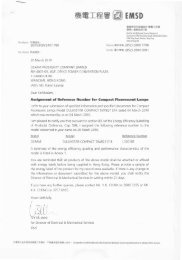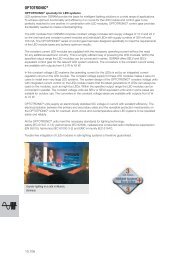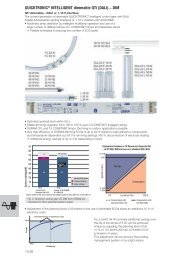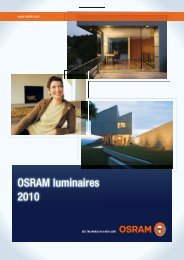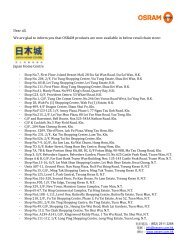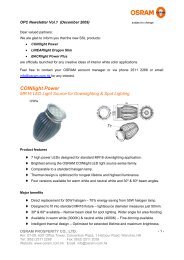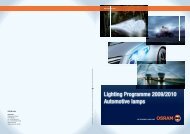Glossary of the most important lighting terms - OSRAM
Glossary of the most important lighting terms - OSRAM
Glossary of the most important lighting terms - OSRAM
Create successful ePaper yourself
Turn your PDF publications into a flip-book with our unique Google optimized e-Paper software.
labeling for luminaires, lamps<br />
and accessories<br />
Products that fall under <strong>the</strong> scope <strong>of</strong> <strong>the</strong> European directives on low voltage (LVD, since 1.1.1995),<br />
electromagnetic compatibility (EMC, since 1.1.1992) and <strong>the</strong> eco-design <strong>of</strong> energy-using products (EuP, since<br />
11.8.2005 and its applicable implementation measures) must carry <strong>the</strong> CE label in order to be sold in <strong>the</strong> EU.<br />
The CE label indicates compliance with <strong>the</strong> principal requirements <strong>of</strong> <strong>the</strong>se directives. Of course, all <strong>OSRAM</strong><br />
products meet <strong>the</strong> requirements <strong>of</strong> <strong>the</strong> relevant European directives and <strong>the</strong>refore carry <strong>the</strong> CE label.<br />
Notes on CE labeling:<br />
1. CE labeling as a requirement for marketing products in Europe.<br />
The CE label is applied to <strong>the</strong> product itself or to its type plate (minimum height <strong>of</strong> <strong>the</strong> label: 5 mm). If this is<br />
not possible in certain circumstances <strong>the</strong> label may be applied to <strong>the</strong> packaging, if any, and also to <strong>the</strong><br />
accompanying paperwork. The CE label is a requirement for sales within <strong>the</strong> EU and must <strong>the</strong>refore be<br />
applied before a product can be marketed. By applying <strong>the</strong> CE label to <strong>the</strong>ir products, manufacturers and<br />
importers are confirming that <strong>the</strong>ir products comply with <strong>the</strong> “basic requirements” <strong>of</strong> special European<br />
directives and ordinances and that <strong>the</strong>y meet <strong>the</strong> stated objectives <strong>of</strong> <strong>the</strong> directives (electromagnetic<br />
compatibility, for example).<br />
As a rule, <strong>the</strong>se “basic requirements” are met if <strong>the</strong> products were manufactured in compliance with <strong>the</strong><br />
relevant ordinances and harmonized European standards.<br />
2. The CE label is an administrative mark<br />
The CE label is an administrative mark addressed to <strong>the</strong> national inspection agencies. The CE label indicates<br />
to <strong>the</strong>se agencies that <strong>the</strong> labeled product complies with European law at <strong>the</strong> time <strong>of</strong> its marketing.<br />
3. Nei<strong>the</strong>r retailers nor consumers have <strong>the</strong> right to inspect <strong>the</strong> conformity certificates <strong>of</strong> <strong>the</strong> manufacturers.<br />
The right to request and inspect conformity certificates is reserved exclusively for those market inspection<br />
agencies responsible for checking that electrical/electronic products comply with statutory requirements.<br />
In Germany <strong>the</strong>se are <strong>the</strong> Bundesnetzagentur (Federal Network Agency, responsible in connection with <strong>the</strong><br />
EMC directive), <strong>the</strong> Gewerbeaufsichtsämter (Trade Supervision Offices, responsible in connection with <strong>the</strong><br />
low-voltage directive), <strong>the</strong> relevant authorities and <strong>the</strong> Bundesanstalt für Materialforschung und -Prüfung<br />
(Federal Agency for Material Research and Testing) as <strong>the</strong> commissioned agency (in connection with <strong>the</strong> EuP<br />
directive).<br />
4. The CE label is not a seal <strong>of</strong> quality or an approval mark<br />
CE labeling relates solely to compliance with <strong>the</strong> statutory “basic requirements” contained in certain directives<br />
and ordinances. It is <strong>the</strong>refore not an indicator <strong>of</strong> <strong>the</strong> quality <strong>of</strong> <strong>the</strong> product. The product features required in<br />
<strong>the</strong> ordinances for implementing <strong>the</strong> EuP directive are verified by <strong>the</strong> manufacturers by means <strong>of</strong> type testing<br />
and confirmed with <strong>the</strong> CE label. As an administrative label required by law, <strong>the</strong> CE label should not be<br />
confused with <strong>the</strong> approval marks (such as ENEC and BEAB marks) issued by independent inspectorates.<br />
These inspectorates do not even check whe<strong>the</strong>r or not a product carries <strong>the</strong> CE label legitimately.<br />
12.28<br />
Member <strong>of</strong> <strong>the</strong><br />
Fördergemeinschaft Gutes Licht (Good Light Association)




